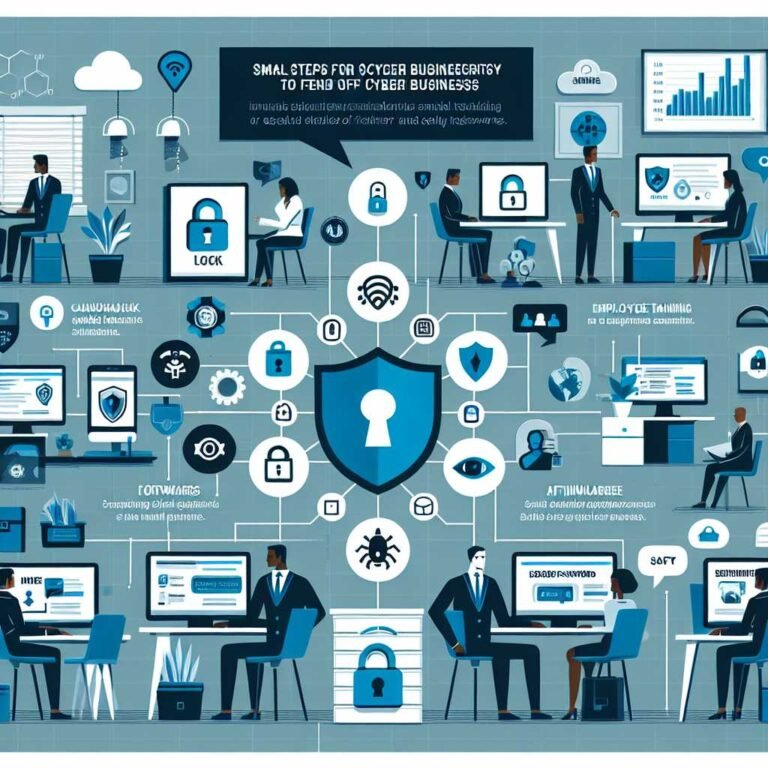RansomHub RDP Attacks: How Password Sprays Opened the Door to a Six-Day Ransomware Nightmare
Imagine waking up to discover your company’s critical files are encrypted, your operations are at a standstill, and a chilling ransom note is staring you in the face—all because of a single, overlooked vulnerability. This isn’t a hypothetical scare tactic. In November 2024, researchers at DFIR Labs traced a sophisticated attack where RansomHub ransomware devastated an organization after a cybercriminal slipped in through an exposed RDP (Remote Desktop Protocol) server, using nothing more than a simple password spray.
If you think that sounds like something that could never happen to you, read on. We’re about to break down exactly how it happened—and, more importantly, what you can do to make sure it doesn’t happen to you.
Why RDP Servers Are a Goldmine for Attackers
Let’s start with the basics. Remote Desktop Protocol (RDP) allows users to control a computer remotely over the Internet. It’s a lifeline for IT admins and remote workers, but when exposed to the open web, it’s also a neon “Welcome” sign for attackers.
Password spray attacks are a favorite technique here. Unlike brute-force attacks (hammering one account with many passwords), password spraying flips the script: attackers try a small set of common passwords across many accounts. That evades lockouts and, statistically, almost always gets a hit.
Here’s why that matters:
– Many organizations leave RDP exposed for convenience.
– Passwords are often weak, reused, or just never updated.
– Attackers automate these attacks, quietly probing thousands of endpoints at a time.
So, if you have an open RDP port and weak credentials, you’re a sitting duck.
Anatomy of the Attack: How RansomHub Infiltrated a Network
Let’s walk through the attack, step by step, so you can see how quickly things spiral out of control.
1. Initial Access: The Password Spray
- Timing: The attack began over a four-hour window.
- Method: The attacker used a password spray attack, targeting multiple accounts with a handful of passwords.
- Result: One weak or compromised password was all it took to gain a foothold.
Analogy: Think of it like a burglar going down a street, gently turning the doorknob on every house. Sooner or later, someone forgot to lock up.
2. Credential Harvesting: The Treasure Hunt Begins
Once inside, the intruder wasted no time. They: – Deployed Mimikatz and Nirsoft—well-known tools that extract saved passwords and authentication tokens. – Accessed LSASS memory (Local Security Authority Subsystem Service), where Windows stores sensitive authentication data, to grab more credentials.
Why this is scary: With these tools, attackers aren’t just in—they’re grabbing the keys to every other door in your digital house.
3. Network Discovery: Scoping Out the Mansion
Next, the attacker wanted to know what else they could reach.
They used so-called living-off-the-land techniques, along with:
– Advanced IP Scanner and NetScan: Tools to map out the network, identify active hosts, and spot valuable targets.
Living-off-the-land means using built-in Windows tools and legitimate software to blend in, making them hard to spot in security logs.
4. Lateral Movement: Spreading the Fire
Armed with fresh credentials, the attacker moved laterally: – RDP was used again for hopping between servers. – Domain controllers and high-value servers were priority targets.
Persistence mechanisms (ways to stay inside, even after a reboot) came next: – Installed Atera and Splashtop—remote management tools that look legit on the surface but give attackers ongoing access.
5. Data Exfiltration: Stealing the Family Jewels
Before launching the ransomware, the attacker wanted to maximize leverage: – Used Rclone over SFTP (Secure File Transfer Protocol) to siphon out sensitive data—documents, emails, anything valuable.
This data is often used for double extortion: “Pay up, or we’ll leak your files.”
6. Ransomware Deployment: The Coup de Grâce
Finally, the main event: – SMB (Server Message Block) protocol enabled rapid, network-wide deployment. – Ransomware executed via remote services, encrypted files, deleted backups (shadow copies), and even killed virtual machines to maximize damage. – A chilling ransom note appeared, linked to the notorious RansomHub group.
Timeline:
Total time from initial breach to ransomware detonation? Just under six days—118 hours of undetected, systematic progression.
Why This Attack Worked: Tactics, Techniques, and Procedures (TTPs) Unpacked
To defend against attacks like these, it helps to understand the attacker’s playbook.
Defense Evasion
- Blended malicious actions with legitimate admin tools (“living off the land”).
- Used commercial remote management tools (Atera, Splashtop) for persistence.
- Cleaned up logs and covered tracks where possible.
Credential Access
- Leveraged credential-dumping tools to escalate privileges.
- Targeted LSASS memory, which is often unprotected.
Lateral Movement
- Relied on protocols and services (RDP, SMB) that might be whitelisted in many environments.
Reconnaissance
- Mapped out the network using both built-in commands and third-party tools.
- Identified high-value targets for maximum impact.
Exfiltration & Impact
- Used encrypted channels (SFTP) for data theft.
- Deployed ransomware with automated scripts, ensuring rapid, widespread encryption.
How You Can Defend Against RDP Ransomware Attacks
If you’re feeling uneasy right now, that’s a good thing—it means you’re ready to act. Here’s how to turn that anxiety into action.
1. Lock Down RDP—Or Close It Entirely
- Restrict RDP access: Limit RDP to only those who absolutely need it.
- Use VPNs: Never expose RDP directly to the Internet. Require VPN access first.
- Implement firewalls: Whitelist IP addresses, use geo-restrictions where possible.
- Enable multi-factor authentication (MFA): Even if credentials leak, MFA blocks most attackers.
2. Harden Credentials and Access
- Enforce strong, unique passwords for all accounts—no exceptions.
- Implement account lockout policies to slow down password spraying.
- Regularly audit accounts—disable or remove unused accounts.
- Monitor for unusual logins or failed login attempts.
3. Fortify Endpoint Security
- Turn on cloud-delivered protection in Microsoft Defender Antivirus (or a comparable solution).
Learn more from Microsoft’s official guidance. - Enable tamper protection to block attackers from disabling security tools.
- Run Endpoint Detection and Response (EDR) in block mode to catch and stop malicious artifacts—even if your main antivirus misses them.
4. Automate Response and Remediation
- Enable full automated investigation and remediation—this allows your security tools to quickly respond to threats without waiting for human intervention.
- Reduce alert fatigue: Automation speeds up response, so security teams can focus on high-priority alerts.
5. Lock Down Lateral Movement
- Turn on attack surface reduction rules: These block common attacker tricks (e.g., blocking process creations from PsExec and WMI commands).
See detailed Microsoft ASR documentation. - Block unnecessary SMB traffic and SMB-based lateral movement.
- Restrict admin privileges—use the principle of least privilege.
6. Back Up and Prepare for the Worst
- Regularly back up critical data—and store copies offline.
- Test your backups: A backup is only good if it actually restores.
- Plan and practice your incident response: When ransomware strikes, speed matters.
Lessons Learned: RansomHub and the State of Ransomware in 2024
This attack wasn’t just about clever hacking. It was about exploiting human error and technical debt:
– Convenience trumped security by leaving RDP open.
– Weak credentials gave attackers a golden ticket.
– Lack of monitoring meant attackers had nearly a week to do their worst.
Here’s the harsh truth: If it could happen to a company with a full IT department, it can happen to anyone. But you’re not powerless.
Expert Tips: Staying Ahead of Ransomware Attackers
Let me put on my security hat for a moment. If you remember nothing else, remember these five essentials:
- Never expose RDP directly to the Internet.
- Use strong, unique passwords—and enforce MFA.
- Keep your security solutions updated and automated.
- Monitor for unusual logins and lateral movement.
- Back up everything, test your backups, and have a plan.
If you need a more in-depth, technical guide, Microsoft’s profile on human-operated ransomware is an excellent resource.
Frequently Asked Questions About RDP Ransomware Attacks
What is a password spray attack, and how is it different from brute-force?
A password spray attack tries a few common passwords across many usernames, reducing the chance of locking accounts. Brute-force attacks, by contrast, hammer one account with many passwords—quickly tripping account lockouts.
Why is RDP such a popular target for ransomware gangs?
RDP gives remote access to a machine as if you’re sitting in front of it. Exposed RDP ports are easy to scan for and, if unprotected, can grant attackers admin-level access with a single weak password.
How quickly can attackers deploy ransomware after getting in?
As shown in this incident, attackers can take less than a week—from initial access to ransomware deployment. Sometimes, it’s even faster.
What are the warning signs of a password spray or RDP attack?
Unusual failed logins from various usernames, unexpected remote access attempts, installation of unfamiliar remote management tools (like Atera or Splashtop), and network scanning activity are all red flags.
Are commercial remote management tools like Atera and Splashtop always malicious?
No, they are legitimate tools used by IT teams. But in the wrong hands, they give attackers persistence and control, hiding in plain sight.
What’s the best first step if I suspect my RDP server is compromised?
Immediately disable RDP access, change all relevant passwords, and initiate a thorough incident response and forensics process. Don’t forget to alert your security provider or in-house team.
Where can I learn more about current ransomware threats?
Check authoritative resources like Microsoft’s Security Blog and BleepingComputer’s Ransomware section.
The Takeaway: Don’t Let Convenience Become Catastrophe
The RansomHub attack wasn’t magic—it was methodical, preventable, and devastating. In a world where threat actors use every tool at their disposal and patience is their weapon, your best defense lies in vigilance, layered security, and relentless preparation.
Ready to take action?
Audit your RDP exposure, review your password policies, and make sure your security posture isn’t built on hope alone. Ransomware doesn’t discriminate, but smart, proactive defense stacks the odds in your favor.
If you found this breakdown helpful, consider subscribing or following for more expert cybersecurity insights—because in this fight, knowledge isn’t just power, it’s protection.
Discover more at InnoVirtuoso.com
I would love some feedback on my writing so if you have any, please don’t hesitate to leave a comment around here or in any platforms that is convenient for you.
For more on tech and other topics, explore InnoVirtuoso.com anytime. Subscribe to my newsletter and join our growing community—we’ll create something magical together. I promise, it’ll never be boring!
Stay updated with the latest news—subscribe to our newsletter today!
Thank you all—wishing you an amazing day ahead!
Read more related Articles at InnoVirtuoso
- How to Completely Turn Off Google AI on Your Android Phone
- The Best AI Jokes of the Month: February Edition
- Introducing SpoofDPI: Bypassing Deep Packet Inspection
- Getting Started with shadps4: Your Guide to the PlayStation 4 Emulator
- Sophos Pricing in 2025: A Guide to Intercept X Endpoint Protection
- The Essential Requirements for Augmented Reality: A Comprehensive Guide
- Harvard: A Legacy of Achievements and a Path Towards the Future
- Unlocking the Secrets of Prompt Engineering: 5 Must-Read Books That Will Revolutionize You







